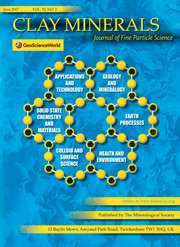No CrossRef data available.
Article contents
Recent work on clays and clay minerals of the Wagingen group
Published online by Cambridge University Press: 14 March 2018
Extract
Clay mineral research was started at Wagingen in 1935 by Dr F. A. van Baren. Later Dr J. Ch. L. Favejee continued his work. Some papers were published on X-ray work, based on Dutch clays. The clay fractions of Dutch clays are mixtures of quartz, illite, kaolinite and montmorillonite in varying proportions. Favejee and Hardon analysed also a number of characteristic soil colloids from Java. The lateritic soils contain kaolinite; the very heavy black clays are montmorillonite, the terra-rossa soils on limestones contain (meta) halloysite; the same mineral was found in the (podzolic) mountain soils. In the true residual soils no mixtures of clay minerals were observed.
- Type
- Research Article
- Information
- Copyright
- Copyright © The Mineralogical Society of Great Britain and Ireland 1947


